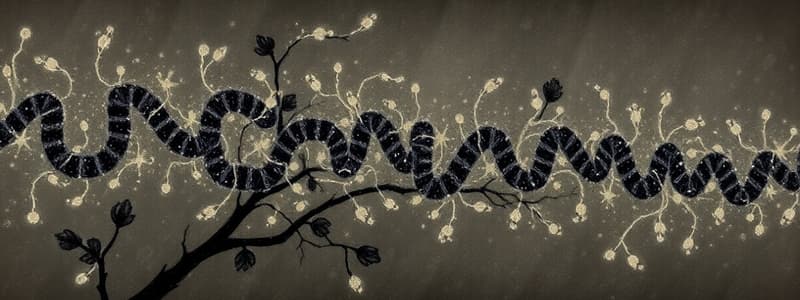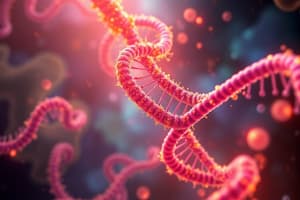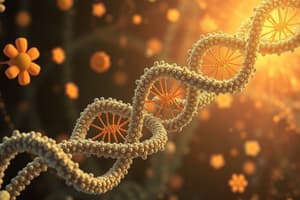Podcast
Questions and Answers
Which amino acid is coded by the mRNA codon 5'-GGC-3'?
Which amino acid is coded by the mRNA codon 5'-GGC-3'?
- Cysteine
- Alanine
- Glycine (correct)
- Serine
An anticodon on tRNA is complementary to a codon on mRNA.
An anticodon on tRNA is complementary to a codon on mRNA.
True (A)
What is the role of transfer RNA (tRNA) in protein synthesis?
What is the role of transfer RNA (tRNA) in protein synthesis?
tRNA carries specific amino acids to the ribosome and matches them to the mRNA codons.
TRNA is responsible for transferring amino acids from the ______ to the ribosome.
TRNA is responsible for transferring amino acids from the ______ to the ribosome.
Match the following RNA types with their functions:
Match the following RNA types with their functions:
What is the primary role of RNA in gene expression?
What is the primary role of RNA in gene expression?
All genes in an organism are expressed at the same time.
All genes in an organism are expressed at the same time.
What is the complementary mRNA sequence for the DNA sequence AAA TAA CCG GAC?
What is the complementary mRNA sequence for the DNA sequence AAA TAA CCG GAC?
The process by which DNA makes RNA is called __________.
The process by which DNA makes RNA is called __________.
Match the following processes with their descriptions:
Match the following processes with their descriptions:
Which statement describes the One gene–one enzyme hypothesis?
Which statement describes the One gene–one enzyme hypothesis?
Uracil replaces thymine in RNA.
Uracil replaces thymine in RNA.
What role do codons play in the process of translation?
What role do codons play in the process of translation?
What is the role of ribosomes in translation?
What is the role of ribosomes in translation?
The codon AUG serves only as a signal for methionine.
The codon AUG serves only as a signal for methionine.
What are the three stages of transcription?
What are the three stages of transcription?
Transcription begins when RNA polymerase binds to the ______ region of DNA.
Transcription begins when RNA polymerase binds to the ______ region of DNA.
Match the following terms with their correct descriptions:
Match the following terms with their correct descriptions:
How many codons function as stop signals in protein synthesis?
How many codons function as stop signals in protein synthesis?
In eukaryotes, the RNA transcript is immediately usable as mRNA.
In eukaryotes, the RNA transcript is immediately usable as mRNA.
What is the basic flow of genetic information according to the Central Dogma?
What is the basic flow of genetic information according to the Central Dogma?
What is the primary role of transcription factors in eukaryotic transcription?
What is the primary role of transcription factors in eukaryotic transcription?
In bacteria, termination of transcription requires the removal of introns from the transcript.
In bacteria, termination of transcription requires the removal of introns from the transcript.
What is the significance of the TATA box in transcription?
What is the significance of the TATA box in transcription?
RNA polymerase adds nucleotides to the ___ end of the growing RNA transcript.
RNA polymerase adds nucleotides to the ___ end of the growing RNA transcript.
What occurs during the elongation phase of transcription?
What occurs during the elongation phase of transcription?
Exons are the noncoding regions that are removed during RNA splicing.
Exons are the noncoding regions that are removed during RNA splicing.
What is the function of the polyadenylation signal in eukaryotic transcription?
What is the function of the polyadenylation signal in eukaryotic transcription?
Flashcards
Transfer RNA (tRNA)
Transfer RNA (tRNA)
A molecule shaped like a clover leaf that carries specific amino acids to the mRNA at the ribosome.
Anticodon
Anticodon
A three nucleotide sequence on a tRNA molecule that is complementary to a codon on the mRNA strand during translation.
Ribosomal RNA (rRNA)
Ribosomal RNA (rRNA)
A type of RNA that forms a structural part of ribosomes, the cellular machinery responsible for protein synthesis.
Translation
Translation
Signup and view all the flashcards
Degeneracy of the Genetic Code
Degeneracy of the Genetic Code
Signup and view all the flashcards
Gene Expression
Gene Expression
Signup and view all the flashcards
Transcription
Transcription
Signup and view all the flashcards
Messenger RNA (mRNA)
Messenger RNA (mRNA)
Signup and view all the flashcards
One gene-one enzyme hypothesis
One gene-one enzyme hypothesis
Signup and view all the flashcards
Ribosome
Ribosome
Signup and view all the flashcards
Regulation of Gene Expression
Regulation of Gene Expression
Signup and view all the flashcards
What are ribosomes?
What are ribosomes?
Signup and view all the flashcards
What is a codon?
What is a codon?
Signup and view all the flashcards
What is the genetic code?
What is the genetic code?
Signup and view all the flashcards
What is the Central Dogma?
What is the Central Dogma?
Signup and view all the flashcards
What is transcription?
What is transcription?
Signup and view all the flashcards
What is translation?
What is translation?
Signup and view all the flashcards
Transcription Start Point
Transcription Start Point
Signup and view all the flashcards
Promoter
Promoter
Signup and view all the flashcards
Transcription Factors
Transcription Factors
Signup and view all the flashcards
Polyadenylation Signal Sequence
Polyadenylation Signal Sequence
Signup and view all the flashcards
Introns
Introns
Signup and view all the flashcards
Exons
Exons
Signup and view all the flashcards
RNA Splicing
RNA Splicing
Signup and view all the flashcards
Study Notes
Gene Expression Overview
- Gene expression is the process by which DNA directs the synthesis of proteins (or RNA in some cases).
- Both prokaryotes and eukaryotes alter gene expression in response to their environments.
- In multicellular eukaryotes, gene expression regulates development. This is because it controls differences in cell types.
- RNA molecules play important roles in gene expression.
Stages of Gene Expression
- Gene expression includes two main stages: transcription and translation.
- Transcription is the synthesis of an RNA copy of a DNA segment.
- Translation is the conversion of the RNA sequence into a polypeptide (protein) sequence.
- The transcription process has three main steps: initiation, elongation, and termination.
Archibald Garrod
- Archibald Garrod (1902) suggested genes dictate phenotypes through enzymes. This is because these enzymes catalyse specific chemical reactions in a cell.
- His suggested "one gene-one enzyme" hypothesis, is that the symptoms of an inherited disease reflect a person's inability to make a particular enzyme.
Basic Principles of Transcription
- DNA makes RNA in a process called transcription.
- DNA code is transcribed into a sequence of codons in messenger RNA (mRNA).
- The base pairing rules are followed: A with U, and C with G.
- Uracil replaces thymine in RNA as there is no thymine in RNA.
Messenger RNA (mRNA)
- Pre-mRNA molecules are broken down after transcription.
- mRNA is made from a DNA template during a process called transcription.
- mRNA carries the DNA code to ribosomes where the message is translated.
- mRNA sequence is broken down after conveying the message.
- For example, if the DNA sequence is AAA TAA CCG GAC, then the complementary mRNA codon sequence is UUU AUU GGC CUG.
Translation
- The process by which mRNA information is used to synthesize a polypeptide is called translation.
- Translation, where there is a change in language from nucleotides to amino acids. The cell translates the nucleotide sequence of mRNA into the amino acid sequence of a polypeptide sequence.
- The sites of translation are ribosomes, molecular complexes that facilitate the orderly linking of amino acids into the polypeptide chain.
Overview of Transcription in Bacteria and Eukaryotes
- In bacterial cells, mRNA produced by transcription is immediately translated without further processing.
- In eukaryotic cells, the nucleus provides a separate compartment for transcription. The original RNA transcript (pre-mRNA) is processed before leaving the nucleus as mRNA.
The Genetic Code
- A sequence of three DNA or RNA nucleotides corresponds to a specific amino acid or a stop signal during protein synthesis.
- mRNA nucleotide triplets (codons) are written in the 5' to 3' direction.
The Codon Table
- The three nucleotide bases of an mRNA codon are designated the first, second, and third bases, reading in the 5' towards 3' direction along the mRNA.
- AUG codon marks the start signal for ribosomes to begin translating mRNA.
- Three codons act as stop signals, marking the endpoints of translation.
Split Genes and RNA Splicing
- Some genes have introns (intervening sequences) that are removed and exons (expressed sequences/coding regions) pieced together to form final mRNA transcript.
- Introns are noncoding regions between coding regions in a gene.
- Exons are the expressed coding regions of a gene.
- RNA splicing removes introns and joins exons, forming functional RNA.
Transfer RNA (tRNA)
- tRNA is a clover-leaf-shaped molecule that carries specific amino acid molecules to the ribosome to help form a polypeptide, during the process of translation.
- It's responsible for transferring amino acids from the cytoplasm to the ribosome.
Ribosomal RNA (rRNA)
- rRNA is a structural molecule that forms part of a ribosome. Ribosomes are made of a large and small subunit
- each subunit is comprised of proteins and one or more rRNA.
Translation Initiation
- A small ribosomal subunit binds to mRNA.
- An initiator tRNA binds to the start codon (AUG).
- A large ribosomal subunit joins to form the translation initiation complex.
Translation Elongation
- Anticodons of incoming aminoacyl tRNAs base-pair with mRNA codons in the A site.
- Peptide bond formation between the amino acids in the A site and the polypeptide chain in the P site.
- The ribosome moves along the mRNA, bringing the next codon to the A site.
Translation Termination
- Release factors bind to stop codons (UAG, UAA, or UGA) in the A site.
- No amino acids are added.
- Peptide chain is released.
- Ribosome subunits dissociate.
mRNA End Alterations
- Modified guanine nucleotide is added to the 5' end (5' cap), and a poly-A tail is added to the 3' end.
- The 5' cap protects mRNA from degradation and facilitates ribosome binding.
- The poly-A tail protects mRNA from degradation and helps with export from the nucleus.
Transcription Summary
- RNA polymerase attaches to a gene's promoter region, unwinding the DNA.
- RNA polymerase adds RNA nucleotides complementary to the DNA template strand.
- Elongation happens until the DNA sequence ends—the terminator sequence is reached.
- RNA polymerase detaches and the new RNA separates from the DNA, allowing the DNA to reform into its double helix structure.
Studying That Suits You
Use AI to generate personalized quizzes and flashcards to suit your learning preferences.




